We've had fake news world ending prophecies for centuries. But now we have exaggerated scientific scenarios to add to the list, so that we can get scared by asteroid impacts, nuclear war, runaway warming and so on. These are mixed with pseudoscience, and hoaxes, to the extent that it's often hard to figure out what is fake doomsday news, what is exaggerated, and what is the sober truth. It's easy to get a feeling of a doomsday helplessness. Yet we are far from helpless. These fake scenarios distract us from many real issues that we can do something about. Some vulnerable people, including teenagers, get so terrified by this fake doomsday news that they become suicidal. I've written many doomsday debunking articles, and have now published a new kindle book Doomsday Debunked. I hope this will help these vulnerable people, as well as everyone else who has trouble sorting out the fact from fiction and exaggeration. It is also available to read for free online. There is no need to feel helpless. There is a lot we can all do to help in one way or another.

Doomsday Debunked also available to read online on my website (free). The idea is to look at the sober truth behind these many doomsday stories, scientific, pseudoscience as well as just plain old fashioned prophecy. All proceeds go to international suicide prevention charities.
DOOMSDAY CLOCK
First, let's look at the problem of scientific exaggeration and hyperbole. If you say "I'm so hungry I could eat a horse" then the listener knows that you don't mean you literally could eat an entire horse or even would want to.

Camargue horse - photo by Wolfgang Staudt. If you use the phrase “I’m so hungry I could eat a horse” everyone knows that you don't mean you could literally eat one, or that you'd want to. It’s an example of hyperbole, exaggerated for effect. Scientific hyperbole can be harder to detect than this.
That is easy for most of us to detect. But it's much harder when scientists use it to try to get decision makers to do something. As they stress the issues of nuclear warfare, they may say that the nuclear weapons could "blow up the world" or "turn the States to radioactive dust". A scientist will know that this is not literally true. It is not a lie, it is just hyperbole, or exaggeration for emotional effect. But a young listener or a non scientist may not pick up on hyperbole so easily sometimes. Those examples come from the Doomsday Clock announcements by respected atomic scientists. The name of the clock itself is hyperbole as it is not about a literal doomsday. I get messages from scared people who think it is about exactly that.
Actually I think it would be more effective if anything, if scientists said that nuclear weapons are ways to carpet bomb entire cities in a moment. It's like the carpet bombing of Dresden in the second world war, scaled up, and with horrible radiation side effects. The worst fallout from a nuclear bomb is so short lived that the most lethal radiation is gone within half an hour. Then there are serious levels of radiation for hours through to days. Scientists have always know this. For details see Worldwide Effects of Nuclear War.
If you can get into shelter from the radioactive dust quickly, you will probably survive like the many survivors of Hiroshima. Within weeks, you would only need to watch out for hot spots of radioactivity left over from the attack (longer term for areas with fallout from ground level nuclear explosions). You'd lose a season of food if it happened in the growing season, and for several decades you would risk cancer if you ate meat from animals that graze on pasture dusted by cesium. But that would be it by way of long term effects.
GROUND BURST ATTACKS
All that is for an air burst. However the earlier airburst weapons were replaced by smaller yield ground burst weapons which would target silos and weapons facilities in a first strike. If the nuclear weapon detonates on or below the ground, as it would in attacks on missile silos, then it can make the soil and other debris radioactive with longer lived isotopes as for the Castle Bravo atomic test which made areas of the Marshall islands uninhabitable even years later. In areas affected by this type of hazard you would need to stay in the shelters for days through to weeks and then once you could leave your shelters, it would still be as unhinhabitable in parts as the Marshall Islands.
After a first strike which targetted weapons silos - then the second strike would be worse in its effect, because assuming all weapons were launched in the first strike, there would be no weapons silos to target, so then they would target industrial and military targets, many of which would be close to cities. They would be smaller bombs but designed for ground bursts. This would lead to more radiation locally and longer lived radiation, however less radiation globally.
These revised scenarios based on military targets rather than civilian ones would of course still have huge effects as many would be targetted at cities and millions would be killed. Also because they are ground bursts, they would lead lead to more radiation effects locally, needing to stay in shelters for weeks and after you can leave your shelter, large parts of the country would be uninhabitable like the Marshall Islands due to long lived radioactiivty. But it's not a worldwide doomsday. Countries not involved in the conflict would not be much affected. A nuclear winter however, if that could happen, would potentially affect everyone, or at least, that's what top scientists in the field thought in the early 1980s.
NUCLEAR WINTER, NUCLEAR AUTUMN, OR NO GLOBAL CLIMATE EFFECTS?
The best models available at the time predicted nuclear winter up to the 1980s. The early 1980s models were shocking in their predictions, of a cooling by 40 to 60 C (70 - 100 F) immediately after the exchange. The idea of a large scale nuclear winter was the consensus up to around the time of the Kuwait oil fires in 1991. Then the way the smoke behaved caused the scientists to question their models of what would happen to dust and smoke in the atmosphere after a global nuclear war.
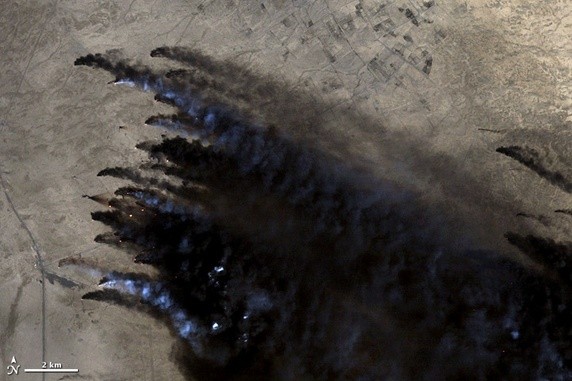
Smoke plumes from the oil fires in Kuwait set alight by the Iraqi military forces as they retreated. Scientists predicted that this would lead to a large scale cooling effect but though much of the Middle East went dark, and dropped a few degrees for a short while, apart from that, nothing happened. This lead them to revise models on how smoke and dust is propagated through the upper atmosphere and they discovered that after a nuclear war, the dust would not go high enough to cause a nuclear winter.
As Carl Sagan (one of the scientists who worked on the nuclear winter models) wrote: "it was pitch black at noon and temperatures dropped 4–6 °C over the Persian Gulf, but not much smoke reached stratospheric altitudes and Asia was spared.”
This lead to them re-evaluating the models that lead to the nuclear winter prediction, which were rather crude by modern standards, making many assumptions and approximations. Modern bombs which are much less than one megaton in size, would throw most of the debris up only as far as 60,000 to 70,000 feet which means the debris will rain to Earth within hours or days, close to the point of impact. Our nuclear arsenals are also much smaller than they were at the time of the nuclear winter calculations. Also our cities are constructed in ways that make fire storms less likely. So in short, some would say that probably even at the height of the cold war, we would not have been plunged into a nuclear winter. As it is now, certainly not. Here I’m summarizing Allen E Hall's answer to In a total nuclear exchange where the entire worlds arsenals are used, how long would the nuclear winter last and would we survive? The models still predict asteroid impact witner, because gaint asteroids can send material high into the stratosphere.
Here is the New York Times retro report on nuclear winter.
This is a paper about the suggestion mentioned towards the end of that report, that even a confrontation between Pakistan and India with 100 15 kt nuclear weapons (50 on each side) involved could have global effects.
". Our calculations show that global ozone losses of 20%–50% over populated areas, levels
unprecedented in human history, would accompany the coldest average surface temperatures in the last 1000 years. We calculate summer enhancements in UV indices of 30%–80% over midlatitudes, suggesting widespread damage to human health, agriculture, and terrestrial and aquatic ecosystems. Killing frosts would reduce growing seasons by 10–40 days per year for 5 years. Surface temperatures would be reduced for more than 25 years due to thermal inertia and albedo effects in the ocean and expanded sea ice. The combined cooling and enhanced UV would put significant pressures on global food supplies and could trigger a global nuclear famine."
So that is the polar opposite of those who say it would have no effect at all.. So, we have views at both ends of the spectrum here. However these predictions for a controntation between Pakistan and India come from a rather simplified model. It's a 3D model, not a 1D approximation and in that sense is detailed. But their starting point is from a point after the initial explosions. They just load the atmosphere with carbon soot over the relevant areas of India and Pakistan, and then run the model forward to see how it continues. Even in a 3D model, that's making lots of assumptions. Would the soot end up in the distribution they suggest?
The situation is complicated. Though many fires would break out in cities, some of them may burn for only a short time. Would they combine together to make a firestorm? They didn't for Nagasake which was a city built largely of wood and paper, which would not be permitted with a modern city. But then they might be ground burst weapons, so what difference does that make? What would the end result be in the atmosphere of the complex pattern of many different fires? What would the vertical distribution be? In the example of the Kuwait fires then most of the carbon was distributed in the first few kilometers and did not reach the stratosphere. Also water vapour is another complicating factor. The fires themselves produce water vapour during combustion and more is taken in from the atmosphere and lofted high where it may form clouds, which then will tend to keep the surface warmer than it would be. Also then the excess moisture rains out taking soot and dust with it. The whole thing is very complex. Here is William Cohen talking about it in his 2007 book. He is an expert who started off by supporting the nuclear winter models but doesn't any more.
So in short it's a wide ranging debate. Some think that some form of a "nuclear autumn" is possible. Others think that there would be no global climate effects at all. The idea of a true nuclear winter, turning summer into winter, is no longer on the table. There are lots of cites to follow up in the Wikipedia page on Nuclear Winter which will help. See it's Scientific Criticism and debate section.
It's still not a literal doomsday if there is a nuclear autumn. It's rather similar to the idea of a volcanic winter after a super volcano, where you'd need to grow different crops, adapted for a colder climate until the temperatures recover. I don't mean that in the sense it is easy of course, but it is possible. It is a very similar situation to the situation after a supervolcano, so I cover that in the section What really happens if Yellowstone erupts as a supervolcano, or if some other supervolcano erupts?
(Edited this after a friend drew attention to this research and modeling by some that is still suggesting nuclear winters)
NULCEAR FREE SOUTHERN HEMISPHERE
The entire southern hemisphere is a nuclear free zone, and without the scenario of a nuclear winter, this means it would experience almost no effects at all from a global nuclear war.
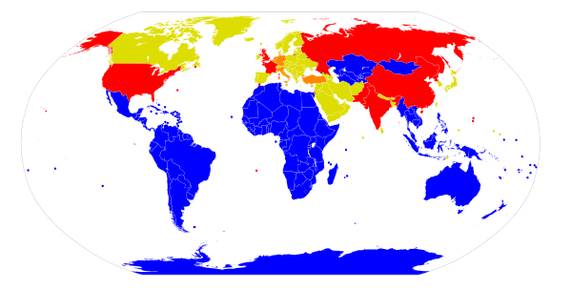
The blue areas here are nuclear free. If we did have a global nuclear war - then there would be no nuclear bombs in those areas at all and no radioactivity either. Also in the areas that are attacked, the harshest radiation is over quickly. The most lethal radiation is nearly all over within half an hour.
The idea that nuclear weapons would cause a nuclear winter has also been shown to be false.
Perhaps if nuclear weapons were thought of like that, as instant city carpet bombing weapons with serious radiation sickness side effects if you are caught in the open close to the attack, it might make it easier to get rid of the things. I think this is an example where perhaps hyperbole actually doesn't help, though it's a natural thing to do.
If you feel you must use hyperbole as a scientist, or you notice that you have just come out with a hyperbole through natural speech, well there is a solution. You can flag it. Say "nuclear weapons could turn the States to radioactive dust - not literally", add the "not literally". It may be a bit lame to do that, but if you are talking to a general audience, it's better than scaring a listener who might take you literally.
So that's a good example of a doomsday scenario that in fact is nothing like doomsday. We have vivid scenarios in popular imagination, movies and books, of a few survivors picking their way through radioactive debris. Or even, everyone dying, as in Nevil Shute's "On the Beach". We may think of them as still risking death centuries later from exploring the cities where the bombs landed. That is a staple of science fiction, but it's a movie / sci-fi trope. You can explore its use in tv / movies / science fiction on the TV tropes website, see
- Artistic License – Nuclear Physics
- Sickly green glow - for some reason radiation is shown as green in films, though it is normally blue in real life, when visible. The radioactive materials, if they get hot enough, glow orange in real life.

This is what Plutonium 238 looks like. It is so radioactive that it glows orange from the heat. Not green, but orange. This form of plutonium is used to power spaceships through conversion of the heat to electrical power. However, it can't sustain chain reactions. Nuclear bombs or conventional nuclear power plants use Plutonium 239. or Uranium 235 instead which are much less radioactive but can sustain a chain reaction.
And this is what a reactor core looks like, glowing with Cherenkov radiation.
This is an example of the "Coconut effect" where audiences come to expect things to be shown in particular ways in movies. E.g. that horses galloping over grass should sound like two half coconuts hit together.
If you click through the links there you'll find many movie tropes that build up a kind of "movie consensus science". Audiences come to expect this as it has been built up over many previous movies they've seen, and it can even seem "wrong" if shown the way things really are. These tropes often get further and further away from reality.
Scientifically a radioactive post nuclear war doomsday is nonsense, at least for the nuclear weapons that we have. After all Hiroshima is a thriving modern city.
COBALT BOMB "DOOMSDAY WEAPON" THOUGHT EXPERIMENT - WE DON'T HAVE ANY
It is possible to design a nuclear weapon to make the Earth uninhabitable. Theoretically if you could dust the entire Earth with cobalt 60 using enough cobalt bombs you could make it uninhabitable to humans - except of course in protected areas - for instance inside domes covering areas that have been cleared of the cobalt 60. The idea originated with Leo Szilard - not intended as a serious proposal for a nuclear bomb, but as a way to show theoretically that humans could in the near future have the capability to design a "Doomsday weapon".
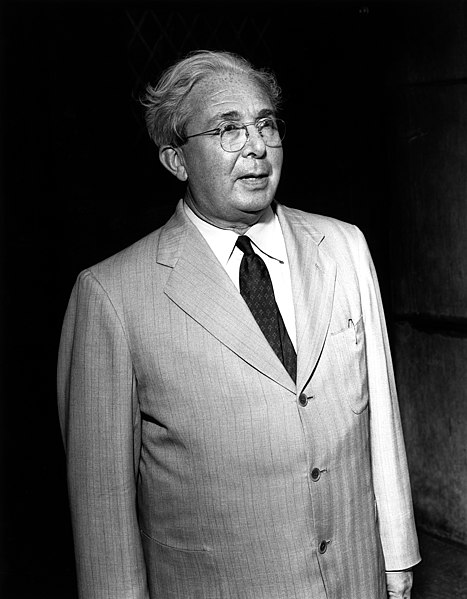
Physicist Leo Szilard who first hypothesized the nuclear chain reaction, and patented the idea of a nuclear reactor.
He devised the theoretical idea of a "Cobalt Bomb". The bomb contains a large amount of ordinary cobalt and the neutrons from the blast turn it into dangerous cobalt 60. It's designed to produce less radiation damage in the first few hours, but more radiation damage over time periods of years and decades. Areas affected would only become habitable to humans a century after the impact. It was just a "thought experiment" to show that we could in principle build doomsday bombs. They would need only of the order of hundreds of kilograms of cobalt.
The idea is that cobalt 60 has a long enough half life so that it could spread throughout the Earth's ecosystems before it decays away enough so that it no longer kills people. In practice it would probably still have a patchy distribution. Anyway we don't need to worry about cobalt bombs. There have been a couple of nuclear tests that produced a small amount of cobalt 60 in the fallout but they were not designed as cobalt weapons. In one case the cobalt came from pellets used as tracers, and in the other case from the steel casing. For more on this see the wikipedia entry on Cobalt Bomb which has lots of cites to follow up.
This is perhaps the closest we have to a doomsday scenario but no such bombs exist. After all it's not to anyone's advantage to make the world uninhabitable. I suppose if you want to fix the nuclear doomsday SF stories you could make the weapons cobalt bombs. That wouldn't work for scenarios that have Earth uninhabitable thousands of years into the future, but would work if the author only needs Earth to be uninhabitable for decades into the future.. If some people were able to survive somehow for as long as a century, underground, or in domed areas cleared of cobalt 60, or because of patchy distribution of the cobalt 60, then after that they'd be able to survive fine though with increased cancer risk for a few more decades. That would fit many post apocalyptic science fiction stories. But it ain't going to happen in our world.
BACKGROUND RADIATION
Now it is true that with our sensitive instruments we can detect the signature of the nuclear bomb tests in sediments and ice cores world wide. Billions of years from now, scientists will be able to detect this, and may mark it as the "onset of the anthropocene", a new geological era marked by the effects of humans on the world. It's been recommended as one proposal to mark the start of this era. There is even plutonium from tests in the 1950s and early 1960s still present in the stratosphere 10 - 50 km above the Earth's surface (it also includes plutonium 238 from the experimental RTG SNAP-9a). Any below 10 km rained out long ago but the few trace amounts that got to higher altitudes are still there.
However we actually experience quite high levels of constant background radiation from cosmic rays. Every moment there are particles from outer space smashing through your body at high speed, some traveling close to the speed of light. But you don't notice because our bodies are adapted to it. You can't see them but you can make these particles visible in a cloud chamber.
Then there are many other sources of natural background radiation on top of that. There are low levels of natural urainium, and thorium, in the soil, and vegetation. We have natural radioactive elements even in our own bodies. Everyone has radioactive potassium 40, carbon 14, lead 210 and other radioactive isotopes in their bodies from birth.. Some rocks such as granite, have natural levels of radioactivity (granite is often used as a building material) because of the naturally occurring radon. In some areas along the coast in the Kerala province of India, residents are exposed to between 4 and 80 microGrays a year from gamma radiation from thorium in monazite sand, yet a study found no sign of any harmful effects on them from these low doses of radiation. Indeed there is even a hypothesis of radiation hormesis, that we benefit from it because the radiation stimulates repair mechanisms in the body. This is very hard to study because of the background rate of cancer anyway. Whether that is true or not, the low levels of radioactivity from the nuclear tests are not enough to cause us any significant level of harm.
This section is a short summary of the chapter in the book: Debunked: A nuclear war would make Earth uninhabitable - and humans extinct.
COULD A US PRESIDENT SUCH AS TRUMP ORDER A NUCLEAR ATTACK WITH JUST A FEW MINUTES NOTICE?
This is true in a legal sense. But in practice if he did that in peace time, then his Defense Secretary and Joint Chiefs of Staff would surely regard him as inseane, or of diminished responsibility, and not follow through the order. It's not a literal button - but rather someone has to do as he says. See also Debunking: a president of the US could order a nuclear attack at a moments notice on a whim (with some new material which I'll add to the book in the next update).
GIANT ASTEROID IMPACT MYTHS
Another scenario that often leads scientists to hyperbole or exaggeration is the asteroid impact myth. This is something you hear said so often - that we risk being hit by an asteroid that could make humans extinct. But do we really?
So, first, it is true that we could be hit by an asteroid. But in their eagerness to influence decision makers, astronomers will focus on the most dramatic and deadly of impacts, such as the one that lead to the extinction of dinosaurs. They may spend much of their precious screen time talking about how huge the largest impacts are, and maybe suggest the end of civilization or even extinction of humans or destruction of all life on the planet. And then of course, movie makers make these scenarios into dramatic films such as the Armageddon movie.
With the scientists it is much more of an error of omission. They may mention the devastating effects if Earth was hit by a large comet like Hale Bopp, around 60 kilometers in diameter. (The more distant C/2002 VQ94 (LINEAR) had a radius of around 50 km so around 100 km in diameter). But they don't then to on to say that the cratering record shows that we have never been hit by anything that large for well over three billion years, or that modeling shows that Jupiter protects us from such large impacts.
In actual fact we can't be hit by an asteroid the size of Texas. Never mind surprised by such an asteroid at the last minute. It is far too large to be missed by even amateur astronomers with a decent sized amateur telescope, years before impact.

Enceladus hovering over the North Sea - this is smaller than the asteroid in Armageddon, and it can be spotted by keen amateur astronomers out as far away as Saturn. Image credit NASA / JPL. You might also like to check out Cirro Villa's image of Enceladus hovering over Southern England half way down this page: Asteroids VS. Your Hometown: Fun but Frightening Graphics Compare Asteroid Sizes to Places on Earth
Voyagers 1 and 2 both took over three years to reach Saturn.
However no need to worry about how many years of warning we'd get as this scenario can't happen at all. We can tell this from solar system modeling backed up by the cratering record. Yes there are huge impact craters like the Aitken basin on the Moon:
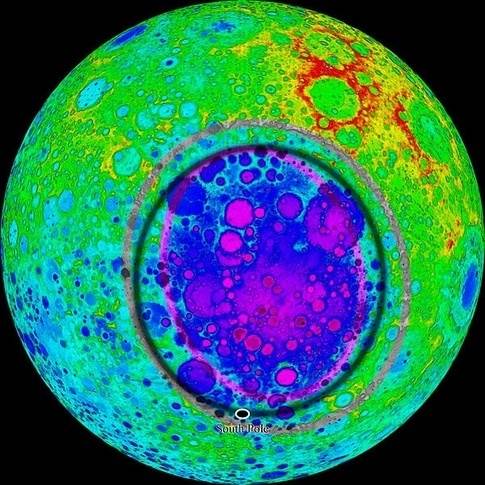
The Aitken basin at the lunar South pole. It's believed to be over 3.8 billion years but the exact date is hard to pin down. Impact of an asteroid perhaps 170 km in diameter.
But all the craters of this size on Mars, Mercury, the Moon and what we have of the history of Earth date from well over three billion years ago. (The crust of Venus is recent, only hundreds of millions of years old, but it has no meteorite craters this large either).
Since then the solar system has settled down and Jupiter protects us from them. We saw just this happen with Comet Shoemaker Levy. It got split into numerous smaller comets

Then it hit Jupiter, leaving these marks in its upper atmosphere, which gradually faded away.
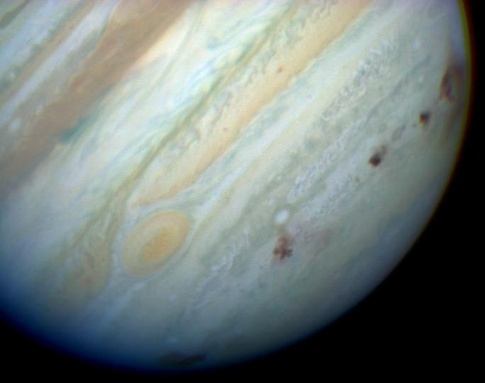
Jupiter isn't quite so good at protecting us from the smaller 10 km scale asteroids and comets, but even for those it takes a lot of them "for the team". The larger 100 km ones simply can't get to us any more because sooner or later they get deflected by the gravitational field of Jupiter which extends over a large part of the solar system. This draws them in to a sequence of events that ends up with them getting torn to pieces, hit the Sun or Jupiter, or ejected from the solar system before their orbit can be flattened into the ecliptic enough to endanger the inner planets.
THE ASTEROIDS THAT COULD HIT US
As for asteroids about the size of New York or London, these could hit us, but are very rare. These get massively overhyped by the media and scientists as well. As quoted in a recent article in the Guardian:: Earth woefully unprepared for surprise comet or asteroid, Nasa scientist warns. Dr Joseph Nuth warns:
“But on the other hand they are the extinction-level events, things like dinosaur killers, they’re 50 to 60 million years apart, essentially. You could say, of course, we’re due, but it’s a random course at that point.”
So in short, he is saying that we are not actually "due" an asteroid impact because it is a random event. But scared people who shared that story missed that part of his quote or didn't understand it. Then it got re-published on many news sites without that qualification.
The chance of such an impact is 1 in 500,000 per century, or 1 in a million per century (for the slightly larger events that happen once every 100 million years), and it is no more likely that an asteroid this large could hit this century than any previous century. It wouldn't make us extinct either, many other species yes, but it's not a human extinction event. See. Why Resilient Humans Would Survive Giant Asteroid Impact - Even With Over 90% Of Species Extinct
But the situation is more optimistic than even that would suggest. The astronomers have had great success in the last couple of decades. They have made good use of the funding they got to detect these asteroids after the wake up call of Shoemaker Levy galvanized decision makers into action. Now they know the orbit precisely for every single major city sized asteroid that does a regular flyby of Earth. As a result, they now know for sure that none of them can hit us before 2100.
IMPACTS BY COMETS THE SIZE OF A CITY - SPOTTED YEARS IN ADVANCE - BUT ARE THEY POSSIBLE AT ALL?
As for comets, then they could be spotted years in advance. Siding Spring, in 2013, only 300 - 700 meters in diameter, was spotted 22 months in advance, with a pre-discovery image from Pan-STARRS from two years before it flew past Mars, (which also happened during its inbound trajectory).
This is Comet Siding Spring's orbit - it is rather extraordinary isn't it? How did it get into such an orbit? And then pass so close to Mars?

If any were headed our way the odds would be hundreds to one against an actual impact and they'd be expected to miss just like comet Siding Spring which missed Mars by more than a third of the distance to the Moon from Earth.
Also, of the 15475 NEOs discovered to date, only 106 are short period comets so about 1 in 146. Based on that, a one in 100 chance of a comet hit seems likely. Also, nearly every day we get a flyby, usually at many times the distance to the Moon, of a Near Earth Object of the order of several hundred meters in diameter - comparable in size to Siding Spring. See the Close Approaches Table for predictions for the near future. We don't get Oort Cloud comets that large doing flybys of Earth every day or even every year or indeed at all in recent times. A close flyby a third of the distance to the Moon by a comet the size of Siding Spring would be a spectacular event.
If this is right, then for the larger 10 km comets, they are so rare that you are talking about a 1 in 100 million chance per century probably, so you can be 99.999999% certain it won't happen. If you aren't used to probabilities - well that means for all intents and purposes we can forget about them.
WHAT ABOUT THE IDEA THAT SOME OF THE MASS EXTINCTIONS IN THE PAST WERE CAUSED BY COMETS?
Some scientists, for instance in this article from 2013 suggesti that the Chicxulub impact could have been a comet. If only one impact in a hundred is a comet, then it would be very unlikely that the last such was by a comet. So if true, that would suggest that there are more large comet impacts than you'd expect from current Near Earth Object statistics.
So - how does that fit with our observations that comets that do flybys of Earth are very rare compared with Near Earth Asteroids?
Well one explanation could be that this is something that varies with time. At present comets are rare but at other times, comets are much more numerous than they are for us today. This increase in numbers of comets could be a result of perturbations of the very distant Oort cloud of comets, which may bring more comets into the inner solar system from time to time. That could be from passing stars, or a distant companion star to Earth (Nemesis) (though that is seen as increasingly unlikely as searches haven't found it and probably should have by now),
Another idea is that every 50,000 or 100, 000 years, a Centaur gets perturbed into the inner solar system. These are small bodies that orbit between Jupiter and Neptune and cross the paths of one or more of the giant planets. Their orbits are unstable over a period of about a million years.
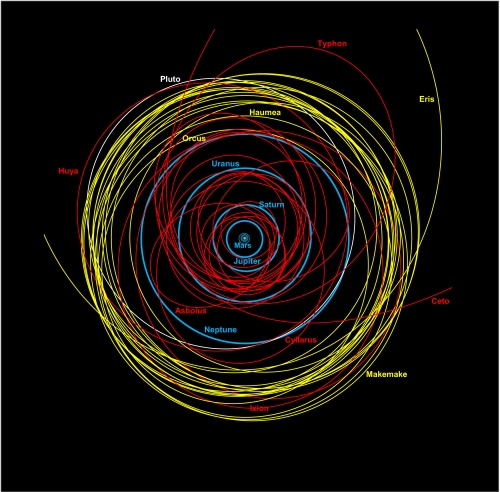
Orbits of 22 out of 400 known Centaurs shown in red, image Credit: Duncan Steel.
Most would get ejected or hit another planet but from time to time then some get broken up by Jupiter and then find their way into the inner solar system as fragments.
If any of these ideas turn out to be correct, well it doesn't make any difference to our risk assessment for the next century or the next thousand years. The evidence suggests we aren't getting unusual amounts of comets from the Oort cloud at present in the inner solar system. So whether this happens in the past, and whether the Chicxulub impactor was a comet, it would seem that we are not in the middle of such an event at present. So, our main risk at present is from NEOs rather than comets.
I understand that this is a matter of active research with scientists on both sides of the debate and we have to see how that pans out in the future. We don't know yet for sure whether any mass extinctions are caused by comets, and how the comets come to hit Earth if they are. Meanwhile, I think a good summary might be that large comets are probably as rare as the small ones. There may be exceptions to this rule at times when the Oort cloud gets perturbed or when a Centaur gets broken up by Jupiter.
Whether that is so or not, our main risk for large impacts, at present, for the next few centuries and probably for the next few thousand years is probably from NEO's. That risk is more or less completely eliminated for the larger asteroids and will be completely eliminated once we find all the 1 km and larger asteroids. This also makes it far more manageable because if you can detect a NEO decades or centuries in advance, even a one kilometer or larger one, then it is easy to deflect it with just a gentle nudge sufficiently so that it misses Earth, and we also have plenty of time to devise a solution. We are still at risk from smaller impacts from comets, indeed some think the Tunguska impact might have been a comet.
ONE KILOMETER ASTEROIDS NEARLY ALL FOUND - AND NOT HEADED FOR EARTH!
In the discovery statistics, 874 are over one kilometer in diameter. Which may seem a lot - but that means 874 one kilometer or larger Near Earth Objects all of which we know can't hit Earth this century. Indeed only one of them, 1950 DA, is predicted to have a chance of hitting Earth at all even many centuries into the future, with a 0.012% chance of an impact in 2880. It's possible that one of the remaining 100 one kilometer asteroids still to be found will be in an orbit that leads to an impact, but this is getting more and more unlikely. By the mid 2020s we should have found 99% of the one kilometer or larger asteroids just following the observation programs we are using so far. This is a remarkable achievement and the result of many long periods of observation on Pan-STARRS and other highly capable asteroid detection telescopes.
New development synthetic tracking of asteroids
This is a very new idea, which came together only early in 2016, and now the favoured way of finding asteroids by the B612 foundation. It gives an order of magnitude reduction in costs from $500 million to $50 million for asteroid detection. The idea is explained in techy detail in this paper. Finding Very Small Near-Earth Asteroids using Synthetic Tracking. For an easier to read summary of it, see “Synthetic Tracking” Set to Revolutionise Near-Earth Asteroid Discovery
The idea is that instead of doing a 30 second exposure, you do many shorter 2 second exposures. With conventional CCD's that adds to the read noise so you get more errors but there are new CCD's developed for medical imaging that permit fast accurate reading, called Scientific CMOS detectors. As an example, the Andor Zyla 5.5 | sCMOS Camera medical imaging camera capable of fast read out with low read error. These can read out from the CCD every 2 seconds instead of every 30 seconds as is needed for Pan-STARRS.
You can then use this to simulate tracking the asteroid with the camera, which makes the asteroid far brighter in the images.
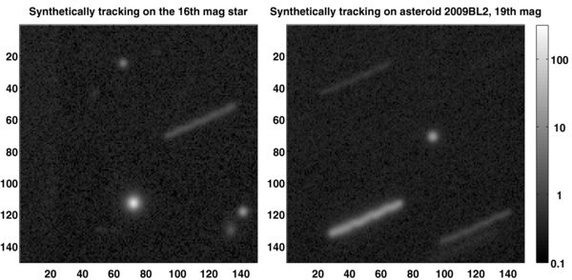
This image shows a the result of stacking many photographs of asteroid 2009BL with camera set to follow the stars on the left - notice how the asteroid is shown as a streak, and rather faint. On the right, the same photos are stacked to follow the asteroid which then shows as a much brighter spot, and the stars are streaked and fainter.
Image from: DETECTION OF A FAINT FAST-MOVING NEAR-EARTH ASTEROID USING THE SYNTHETIC TRACKING TECHNIQUE
When the asteroid is small and traveling faster across the field of view, the trail can be so faint it can’t be distinguished from background noise when the camera follows the stars. If you know its velocity you can make it much brighter by following the asteroid. But what can you do if you haven’t detected it yet and don’t know which way it is moving? The idea of synthetic tracking is that you stack these short exposure photos in many different ways until you find the right velocity and an asteroid pops into vie win the photo. The final key to this s that modern consumer type graphics cards designed for computer games do many calculations simultaneously for things like textures, shading, ray tracing, game physics etc. By taking advantage of this capability, synthetic tracking becomes feasible.
This approach can make it easier to spot fainter asteroids. It might mean for instance that you can spot an asteroid ten times further away than before. That means a thousand times the volume of space covered. So this technique can lead to a huge increase in the detection of asteroids.
We could retire most of the asteroid impact risk for $50 million with this new technique
The researchers found that fewer than eight cubesats, fitted with 15 centimeter synthetic tracking telescopes could find more than 70% of NEO's larger than 45 meters in diameter in less than six years (these are the asteroids that are most hazardous for us). The total cost would be $50 million. With larger 30 cm telescopes then eight satellites could find 95% of the NEOs larger than 45 meters in diameter in the same time period of less than six years. For details see their 2016 Annual Progress Report.
MORE EFFECTIVE MESSAGE FOR SCIENTISTS
I think myself that though this hyperbole and focus on extremely huge asteroids is a natural human thing to do, it would be much more effective for scientists to approach it in a completely different direction, to present a sober and measured assessment of the situation. Also instead of focusing on the doom and gloom, focus on the positives. We have had remarkable success with the larger 1 kilometer asteroids and larger. We've found 90% of them already and 100% of the ones of 10 km and larger of the ones that do frequent flybys of Earth.
Instead I think a far more effective message would be something like this:
"Look how we have already made great use of the funding so far and eliminated the threat of 10 km asteroids and proven that 100 km ones can't happen. We still risk smaller asteroids of 20 meters upwards, especially 45 meters upwards.
These can't destroy a civilization or make species extinct world wide, but they could kill millions if they landed on a city. The chance of this is tiny but it's not impossible, and it's the one natural disaster we can predict to the minute, and if predicted long enough in advance, prevent also. For just $50 million to launch eight cubesats equipped with synthetic tracking, we could discover most of the ones down to 45 meters within six and a half years
With a decade or two of warning just the gentlest of nudges of millimeters per second of delta v can mean that it changes from a hit to a miss. So the first priority is to find them".
It's not such a dramatic message, it might not hit the news in quite the same way, but it would be a significant news story all the same, and effective. There are decision makers who would respond to this. Hillary Clinton for one has said that she thinks the threat from asteroid impacts is of great importance. Someone like that might even be able to find the $50 million through wealthy friends. Who knows, maybe Donald Trump also could be convinced of the value of this. Or any advanced country, the UK, India, Norway, Switzerland, or a wealthy individual. Even a major lottery winner could surprise us and use their winnings to protect the Earth by eliminating most of the remaining threat from asteroid impacts. This of course does not mean that we should ignore other major issues. But it's a tiny sum. The UK could find the funding with a one off payment of $0.78 per inhabitant (£0.62) and for the US it would be 16 cents per inhabitant, one off cost, to help protect the whole world from this threat. The chance is that we don't need to do anything more, but if we do find something headed our way as a result of the search, it would be easy to find the funding to deflect it at that point so there would be no need to budget for deflection.
For more on this see ASTEROID IMPACTS in the book.
- Debunked: Earth could be struck by a huge asteroid hundreds of kilometers across
- How did we miss the Chelyabinsk asteroid?
- Why Resilient Humans Would Survive Giant Asteroid Impact - Even With Over 90% Of Species Extinct
- Debunked: 2002 NT7 is going to hit Earth in 2019
- Debunked: Earth faces a century of 400 giant impacts starting in 2017
- Debunking: All going to die as a result of impact of Asteroid 2009ES or 2000 ET70 or [insert name of asteroid here] or a “Level 3 Planet Cracker”
- Debunked: NASA warns that 1000 asteroids might hit Earth in the next five years
AGE OF STUPID
So, those are some of the scientific scenarios. There are many more. For instance the "Age of Stupid" greatly exaggerates the effects of global warming in order to galvanize decision makers into action. It's mainly based on the book "six degrees" by the journalist and environmental activist Mark Lynas, whose degree is in history and politics. He explains his slant on the science behind the film here: The Science. The met office says that the events it describes could happen, although not on the timeline of the film - and the film also exaggerates the scale for dramatic effect, much as Armageddon exaggerates the size of the asteroid hugely, for the sake of drama. I think that these exaggerations and hyperbole actually deflect attention from the real issues we do face, of global warming, extinction of species, nuclear proliferation and so on, Especially so, if it is not made clear to the viewer that it is hyperbole.
There is a lot of hyperbole in popular accounts of global warming. A sober assessment of the situation is plenty enough to lead us to action. For more on this see the sections in the book:
- Debunked: Climate change will make the world too hot for humans
- Debunked: Global warming as terrifying apocalyptic scenario - risking something not far off Venus
- Debunked: If we cut down all the forests we will run out of oxygen to breathe - they are not the “lungs of the planet” in any literal sense
I talk a bit about the science and about exaggerations here: President Elect Trump - Why Climate Change Is No Longer A Political Issue Outside The US. And this is very detailed, about the science behind climate change models: Order Patterned With Chaos - How Climate Is Predicted For Decades - With Exact Forecasts Only For Days
OTHER SCIENCE DOOMSDAY SCENARIOS DEBUNKED
For other science doomsday scenarios which have been in the news recently, see
- Debunked - California could fall into the sea or the Earth split open through earthquakes or continental drift
- What really happens if Yellowstone erupts as a supervolcano, or if some other supervolcano erupts?
- Debunking: Stephen Hawking Says Universe is on the brink of instability and could collapse - metastable, in a false vacuum state.
- Debunked - Stephen Hawking puts an expiry date on humanity
- Debunk: Our Sun or Earth could be hit by a neutron star, black hole or star
- Debunked: A gamma ray burst could make humans extinct
- Debunked: Universe will end with a “Big Rip”
- Debunked: A Solar Storm Put A Crack In Earth's Magnetic Field
- Debunked: We are endangered by “Star Quakes”
- Debunking: Solar Storms to end all life on Earth
- Debunked: The Doomsday argument
- Debunked: Magnetar SGR 1806-20 is going to send a gamma ray blast on 26th December which will be devastating to Earth
2012 - AND PROPHECIES
However in my experience and the experience of others such as David Morrison, a very distinguished NASA astrobiologist and meteorite impact specialist, who first drew our attention to the issue, the stories that scare most people are pseudoscience. Perhaps many of us first became aware of this in 2012. I had the experience perhaps many of you had of conversations with highly intelligent non scientists who said things to me like "I'm not worried that we all may die on December 21st because I could die at any time anyway and it's not like there is anything we could do to stop it". I mean, seriously, did you actually believe that pile of stinking bullshit?
First it was based on an alleged prophecy by Mayans. A small amount of research would show that the Mayans didn't actually prophecy anything. It was just the end of a cycle. And as it turns out, it wasn't even the end of the "Long count". Their mythological pre-history count ends after 13 baktuns. But for some reason the current one ends after 20 cycles in 4772 so completing one piktun. Their calendar is not exactly very logical in this way.
REPETITION AND PROPAGANDA
But why should any of that matter anyway. We are not Mayans. They were pretty good at astronomy yes, though not a patch on us. But it wasn't an astronomical prediction anyway. Why should a date on a Mayan ca lender mean anything to us? Yet according to one poll, an estimated 10% or the world population, and as much as 20% of the Chinese agreed with the statement that
"the Mayan calendar, which some say 'ends' in 2012, marks the end of the world."
2% of the world population, according to this poll, strongly agreed with this statement. 8% somewhat agreed.
I think a lot of this is due to repetition on the news, in an effect similar to war time propaganda and ad campaigns. Repeat anything often enough and people start to believe it. Even the ones who think they are not vulnerable to suggestion may succumb after enough repetition. It was in the news a lot at the time, often with very little by way of debunking. Also the makers of the movie 2012 promoted the idea heavily in order to drum up interest in their movie.
That was just pure "prophecy" - well except it wasn't a prophecy at all as it happens - but there wasn't any suggestion that the ancient Mayans based this alleged prophecy on science. However, they reinforced this with pseudoscience as well.
DEADLY RADIATION FROM GALACTIC CORE MYTH
They combined the alleged "prophecy" with a claim that we would die through deadly radiation from the core of our galaxy somehow focused on Earth by the Sun because the Sun they claimed was between us and the galactic core on winter solstice. Actually this very rough alignment happens two days earlier on the 19th December and actually the Sun passes a long way to one side of the galactic core in the night sky - it's just nearest to it on that date. And it is just a line of sight effect and is no danger at all. And happens every year at that time. For more on this see Phil Platt's article which he published just before the event was supposed to happen.
But many people bought into that pseudoscience, hook, line and sinker, as they say. To this day the winter solstice is a time of worry for them, that somehow the Earth may get blasted by deadly radiation from the core of our galaxy. To put this into perspective - the core of our galaxy is so far away that the light we see now left it during the last ice age when there was ice kilometers thick over New York and London.
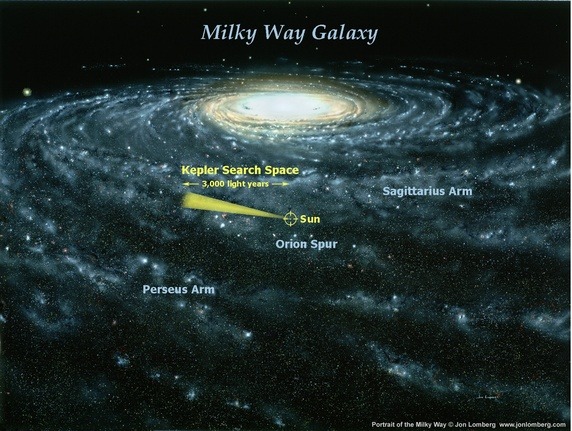
Kepler Search Space - this is an artist’s impression to show the direction in which the Kepler mission did an intensive search for exoplanets by looking for dips in starlight from planets passing in front -anyway it gives a good impression of our position in the galaxy.
Earth is orbiting the sun, roughly parallel to the plane of the galaxy. Sometimes it is on the far side of the Sun from the center of the milky way (at winter solstice) and sometimes on the near side of the Sun (summer solstice). It is so close to the Sun that on this scale you wouldn’t be able to tell it apart from the Sun itself.
Can you see that whether it happens to be between the Sun and the galactic center or vice versa is of absolutely no significance whatsoever?
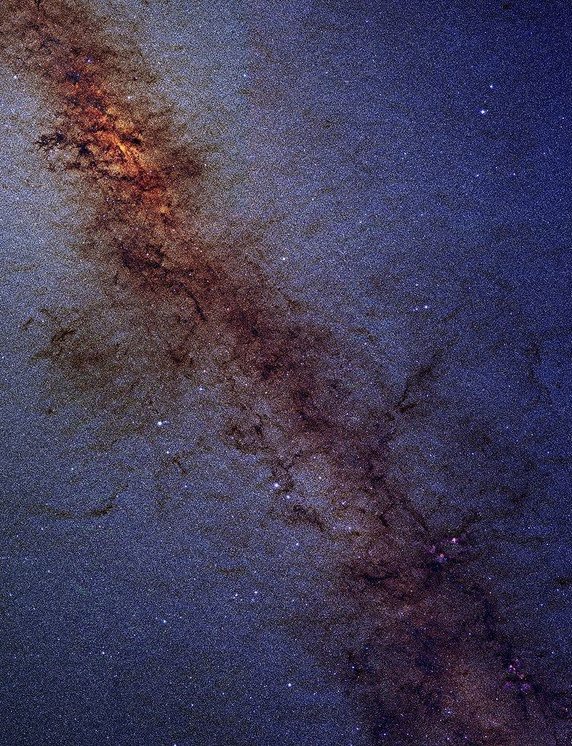
This is the Galactic Center. The sky in that direction is particularly crowded with stars - most of those stars are very close to us, and we look through a haze of them to the very distant galactic center around 25,000 to 28,000 light years away. All those stars are between us and the galactic center along with many others that are too faint and distant to be seen. The light that reaches us just now from the galactic center left it at a time when London and New York were covered in ice sheets kilometers deep in the depths of the last ice age.
Here is a video about the galactic center:
It is of absolutely no consequence at all that once a year Earth is roughly at the opposite side of the sun from the galactic core, as explained in the video.
For more about this, see
For other pseudoscience doomsday scenarios that have been in the news recently, see:
- Debunked: Supermoon is the beginning of the end of the world
- Debunked - an alignment of the visible planets behind the sun on 23rd September 2017 is a sign of the end of the world.
- Debunked: NASA says that Earth will enter total darkness for 15 days in November
- Debunking: Inuit elders say that the Earth’s poles have shifted position
- Debunking: Halley’s comet is going to hit Earth this week.
NIBIRU MYTH AND SUICIDES
So that is bad enough, but then the "Nibiru" people got in on the act. If you are an astronomer or scientists you have probably never heard of it. Astronomers never discuss it, it never appears in astronomy magazines, or journals. For my readers who have come to believe in this "Nibiru", try searching any online forum where amateur and professional astronomers gather. For instance the Star Gazers Lounge in the UK which becomes very active each year after the Star Gazers Live show on TV. Search for any planet, say Neptune, you find 2,581 results (as of searching today). Search for Nibiru and you get 0 results.
But now search on google for Nibiru and you may be astonished at how much there is on the topic. And just as with 2012, if you get hooked on this and start watching these videos - you may come to believe the most extraordinary things. I get contacted by people who think we have two suns, and even a second entire solar system which is about to hit the Earth.
You may wonder how that is possible. I did when I first started to get comments about it. But this is the top question I get asked - do we have a second sun or an extra planet in the solar system that nobody knows about? David Morrison first drew everyone's attention to this back in 2012. He used to answer questions from the public for NASA's "Ask an Astrobiologist" column.
We need to remember that readers of these stories include young teenagers, adults with learning difficulties, and many who flunked physics at school, and decided that this was not for them. They are not able to judge these stories scientifically. He talks about how he got emails from suicidal people and anecdotally was told of several actual suicides. And at least one suicide is confirmed. Back in 2012 a sixteen year old schoolgirl Isobel killed herself, because she was so scared the world was going to end in 2012.
I get many emails and comments here from scared people, terrified, including children as young as 14, quite commonly. Sometimes they say they are suicidal or that they used to be until they read my articles. Sometimes parents talk about even younger children. Perhaps I can quote one of my comments from my petition, a plea to journalists for responsible reporting of these stories:
"I have a 10 year old daughter who has been affected by these kinds of videos, asking such this as " can we build a bomb shelter" and having nightmares about the world ending . No 10 year old child should have those kinds of worries"
Many of my conversations are public here on Science20 so you can take a look at them yourself. My article with most comments is "Imaginary Bullshit Planet Nibiru" with over 1000 comments That includes replies so that's about 500 posts from scared people.
Actually with the people who contact me, I'm not sure I'd say they have a phobia, so I'm not sure that "cosmophobia" is the right word for it - it may be for some but I'm not sure it applies to most who contact me. They don't say they are scared of the cosmos or the night or daytime sky or the universe. What they say over and over is that they find the many doomsday videos and news stories scary. Scary because they come to believe they are true. So what can we do about this? Well I have tried many things, but surprisingly, one of the most effective is just to give them a list of things to look out for to test to see if a site is bullshit. The main problem, it turns out, is that they just don't know how to evaluate these videos, stories and blogs.So, if you are one of those scared of Nibiru, my BS check list may help:
NIBIRU BULLSHIT TESTER - HOW TO CHECK IF THEY KNOW ANYTHING ABOUT ASTRONOMY
Many of the Nibiru website authors claim to be very knowledgeable about astronomy. It is easy to test though, and find out that they don't understand this stuff. Here are some things they may say which immediately show they are mistaken, don’t have the most basic understanding of astronomy, and don't check their sources.
- If they say IRAS found a planet in 1983 - they are wrong - just follow the links that the debunkers give and you can confirm for yourself that IRAS did not find any planets
- If they say Robert Harrington found planet X and was silenced - they are wrong - his theory was proven to be false six months before he died by Myles Standish
- If they say a planet can hide behind or near the sun for years on end then suddenly appear, they are wrong
- If they say that the Earth's geographical poles have shifted, easy to show they are wrong by checking any starry night, couple of observations and you see that our pole star is still due North. (Magnetic poles do swap places every few tens of thousands of years but there is no sign of that at present and it would not cause earthquakes if they did)
- If they publish a lens flare or an offset lens reflection or sunlight lighting up a patch on clouds, and claim it is Nibiru this shows they are very gullible and don’t understand the basics of astronomy.
- If they post a distant object in Google sky, such as a planetary nebula, hundreds, or thousands of light years away and claim it is Nibiru they are wrong
- If they claim we have two suns, easy to check, just block out our sun with one finger, and you can see they are wrong
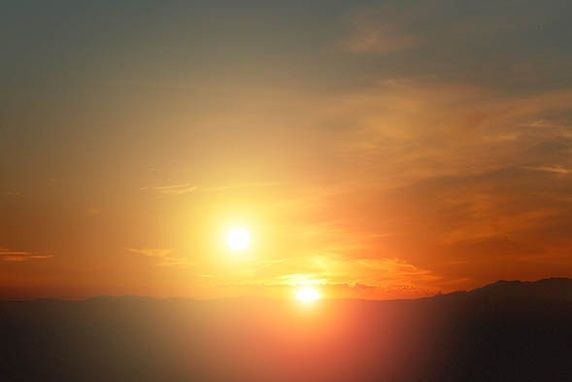
This rather dramatic image has gone the rounds a bit and been posted as a photograph of a double sunset in China. It's actually an artist's impression from NASA of a double sunset over an alien planet.
If someone tells you that we have two suns - then you know they are speaking BS. Click away as that means they don’t have the first clue about astronomy.
It is dead easy to check that we have only one sun. Hold a finger in front of it (don’t stare at the Sun as you won’t know if your eyes get damaged) With the sun blocked, do you see a second sun to either side, or above or below? No! Therefore we have only one sun. It really is as easy as that to debunk this one.
- If they say that the astronomers' Planet X or Tyche or Nemesis are Nibiru, they are wrong as all the astronomer's hypothetical planets are hypotheses for planets that orbit permanently way beyond Neptune - if they exist they are no more of a danger to Earth than Neptune or Jupiter.
- If they say that the Nemesis theory predicts end of Earth in the near future they are wrong - the theory (which is more or less disproved now) predicted a possibility of mass extinctions at various dates around 15 million years into the future.
- If they say that Nibiru is in a 3600 year orbit that goes from outside Pluto to Earth, that's an orbit that is not stable for as long as a million years so they are wrong
- If they say that “Planet 9” is Nibiru, then they are wrong as it always orbits well beyond Neptune, if it exists at all.
- If they say a brown dwarf is invisible they are wrong - a brown dwarf is no more invisible than you or me (we also are infrared sources as we are quite warm).
If anyone says any of these things and claims to be an expert in astronomy - that’s like someone telling you that Usain Bolt is a top seeded tennis player and won Wimbledon and then claiming to be an expert on sport.
That wouldn’t lead you to suddenly wonder if he really is a tennis player and wonder if all the Olympic finals were faked to make him out to be a sprinter. You’d just look at the person who said this askance, or indeed aghast, and then from then on you’d probably never trust anything they say on matters of sport.

Usain Bolt winning the 100 meters in Bejing in 2008. If someone told you he was a top seeded tennis player - that would just lead you to treat that person as someone who doesn’t know what they are talking about in matters of sport.
So - it’s like that if you have even a basic understanding of astronomy and someone says any of those things I listed, or posts them on a website, or a YouTube video, you immediately know that this person knows nothing at all about astronomy. They know as much about astronomy as the person who said that Usain Bolt was a tennis player knows about sport.
There are many other things they say that are immediate giveaways that they don't have the first clue about astronomy. Indeed if an article claims to be astronomical and uses the words Nibiru or Hercobulus or Wormwood, then unless it is a debunking site, that is a giveaway sign that the author knows nothing of modern astronomy. But what I've listed there already deals with 99% of them probably. That is except for the ones that have no astronomy and just base their prophecies on miracles and the Bible or such like.
If anyone says any of those things, they don't understand astronomy, just click away. See also my Debunking: You can’t trust anyone except the Nibiru people - everyone else is a paid shill of the government or in some other way motivated to propagate falsehoods
And for why astronomers are sure that Nibiru is just nuts, see
Debunked: Nibiru will hit Earth on [Insert Date here]
For more about this see the section on NIBIRU / PLANET X / TWO SUNS in the book
PROPHECIES
2012 wasn't an isolated case. Doomsday prophecies are very common, several so far this year. They don't claim any scientific basis at all. It just needs someone to claim that Nostradamus or Baba Vanga or the Bible predicts the end of the world - and without a shred of science, just ideas spun out of paper then that's enough to scare people. Indeed it doesn't even need to be anyone famous. Not even anyone with a name, just an anonymous youtube uploader which nobody knows anything about, can be enough to scare people.
One of the worst incidents came this last summer when the Telegraph, a respectable online news site in the UK, chose to run a story that the world was going to end on July 29th. This scared many people. I got comments from them on my articles here asking things such as when the world would end in their timezone. The comments built up to a crescendo on the day that the world was supposed to end.
The only basis for this was a youtube video that was itself an unauthorized copy of someone else's video, which used amateur graphics to illustrate events such as stars falling from the sky, the whole Earth shaking, and images from Biblical stories in the sky. There is no way to know who it was, hidden behind their youtube channel name. This unauthorized uploader added a title "Why the World will End Surely on 29th July 2016? Shocking Facts" and a custom thumbnail. So that was it, the sole basis of all the fear, a date made up by an anonymous uploader and typed into the title edit field of a youtube video.
That was all that was needed for the Telegraph to run a doomsday story with a count down timer to the end of the world. They illustrated it with a fuzzed out image of the Cassiopea A supernova remnant (which had nothing to do with the story, just looks dramatic).
A blurred out image of the Casssiopea A supernova remnant. It's 11,000 light years away and is of not the slightest risk to Earth. For some reason this blurred photo is often used as illustrations for journalist's doomsday stories like the one the Telegraph ran in July 2016 with a count down timer to the end of the world which scared many people.
This story in the Telegraph was I think meant as a silly season joke. But it was written in a restrained humorous fashion that scared people just didn't get, a bit like an April Fools joke. If you looked carefully some of the fake tweets by famous people were humorous in tone - and that was all there was to show that it was meant to be humorous. Other papers then ran this story, though without the drama of a count down timer, including the Independent, the Mirror, and Metro magazine (who published the denouncement of the re-uploaded video by its original author).
The channel was eventually taken down by youtube, but not before it earned its creator an estimated £945- £15.1K of ad revenue with over 9 million views, for a channel that consisted entirely of multiple copies of the same video. After July 29th they changed the date in the title and got some more coverage. There is no way to know who the anonymous uploader was or anything about them. Except that there are now many youtube channels that churn out "Nibiru" videos one after another. They earn their owners thousands of dollars a month. It is an easy living for them - just upload a video or two every week, more or less identical to all the others, and then holiday in the Bahamas or whatever they do with their ill gotten gains - well I think it's ill gotten anyway!.See Social Blade search for Nibiru and Planet X. There are some astronomers who make videos debunking them, Dave Greg (dazzathecameraman) and Scott Fergusson.
So those are amongst the worst perpetrators here. The astronomers who try to debunk them dub them "Nibtards". They are not using that word to describe the people who are taken in, but rather, these folk who make these doomsday youtube videos just for the ad revenue from the few percent who click on their ads. There are genuine video channels as well by uploaders who believe this stuff, without ads. For instance Pastor Paul Begley seems genuine enough, doesn't run any ads on his videos, but just seems to believe just about every doomsday hoax story that he reads on the internet or that anyone sends to him. He then describes them at great length in his video channel.
It's because so many people get scared about these pseudoscience and prophecy stories that I have large sections of the book about them. I also found that many of those who contact me have no idea how to set about identifying reliable sources and haven't been taught how to do this by anyone else. The basic idea that everyone learns at college, of treating a source as unreliable if it publishes false information, and checking the sources, just doesn't occur to them. Instead they try to evaluate trustworthiness of sources by how much publicity they get, how much "buzz there is", how many people seem to be talking about them, and how impressive it seems. Images and video they find striking, combined with an authoritative voice over and stirring music can convince them to believe almost anything. So I have a large section about WHO TO TRUST to try to help with this issue.
For prophecies generally see the section on PROPHECY
Including:
- Debunked - The world will end because the Bible (or some other sacred book) says so
- Debunked: Baba Vanga from the Balkans predicted xyz, e.g. that President Obama would be the last US president
- Debunked: Have these three sisters predicted the Apocalypse
- Debunked: Doomsday scenarios predicted using an Ouija board
- Debunked: Trump (or any other president or president elect) is the Anti Christ
- Debunked: Nostrodamus predicted the end of the world on [insert date here]
- Debunked: The eclipse in the US in August 2017 will mark the start of the end of the world
- Debunked: Why the World will End Surely on 17th February 2017? Shocking Facts
WHAT CAN WE DO?
There is much we can do to help. First, if you are a scientist:
- Avoid exaggeration and hyperbole in press release statements or interviews - or flag it clearly as hyperbole even if it seems lame to do so
- If you have the time you can also join one of our facebook groups to help reassure scared people that the world is not about to end as a result of the latest doomsday science or pseudo science story to hit the headlines
- You could help me answer some of the comments by scared people on my blog posts here.
- Write quora answers on the topic of Nibiru / planet X and other stories like that.
- Publish science blog posts to debunk the scenarios
If you are scared by Nibiru
- Join one or all of our facebook groups and talk to others about it, help them by sharing your fears with them, show that they aren't the only ones going through this.
- Once you get over your fear, and learn that the stories are nonsense, you may be able to help others who are in the same situation you were in before
- Post any stories that scare you there for the scientists and astronomers to debunk.
If you are a journalist:
- Write debunking stories. They can actually attract more readers than the stories they debunk
- Do basic fact checking. You would never run an obituary without checking with a reliable source that the person has died. Similarly, next time you get an asteroid impact story, just go here: Current Impact Risk. If the first entry is blue or white, the story is a false or exaggerated. If it is yellow (or extremely unlikely, orange or red) then it should be easy to get an astronomer to explain it to you. This basic fact checking would eliminate all the asteroid impact stories published in the last year.
- Check your stories for doomsday hyperbole and exaggeration, including use of the word "doomsday" itself. Also check for statements that could be taken out of context and cause panic such as the "You could say, of course, we’re due," for an impact from a city sized asteroid.
- Help spread awareness of these issues.
For youtube:
- Youtube could help by stopping google ads on fake news videos that predict that the world is going to end - as there are many youtube channels that earn their creators thousands of dollars a month of ad revenue from doomsday videos. It wouldn't put an end to all the videos - but it will end many of them, probably the majority indeed as these commercial run, ad funded youtube channels churn out large numbers of the videos.
Youtube already remove ads from many videos. For instance an ISIS beheading video would not have ad revenue as they won't run them on any videos that show extreme violence. It's nothing to do with freedom of speech, it's just to do with the economics. Youtube don't want to earn money in an unethical way. So, should uploaders be rewarded with ad revenue for providing fake news doomsday videos? Youtube could stop the majority of the doomsday channels right away by stopping the ads - many are only doing this for the ad revenue. The ones that are not being made for the ad revenue, such as Pastor Paul Begley's channel, of course would continue as before. While the ones who do it just for the ad revenue would stop right away so it would soon sort out which are genuine and which are just doing it for the money.
For anyone
- Sign and share the petitions (next section)
- Help spread awareness of this issue of people who get scared, even suicidal, by doomsday stories.
PETITIONS ON CHANGE.ORG - SIGN AND SHARE TO HELP MAKE A DIFFERENCE
Those who worry about these things often tell me that they can't find any doomsday debunking stories apart from mine, since 2012. If you are a journalist, please consider writing stories that they can read so they don't get the very false impression that everyone thinks the world is about to end.
For scientists writing about asteroids, global warming, nuclear war and so on, try running things past anyone vulnerable, for instance a ten year old, and find out what their take home message is from your presentation. You might be surprised about how it differs from the message that scientists like yourself and your colleagues get. You might then notice hyperbole such as saying that nuclear bombs would turn the States to radioactive dust more easily.
Do sign and share the petitions which I started on Change.org. They are:
- Petition to YouTube to Halt Ads on Doomsday Videos
- Plea (to Journalists and Scientists): Debunk Rather than Dramatize "Doomsday" Stories - The Vulnerable Get Suicidal
WHERE TO FIND THE BOOK "DOOMSDAY DEBUNKED"
For lots more about asteroid impacts, climate change exaggerations ,
- Buy it from Amazon as a booklet for kindle

Doomsday Debunked - kindle edition
- Read it online on my website (free).
- Some of you might also find Pocket useful - I've been suggested this by a keen reader of my posts. It lets you read articles offline without any internet connection. It's free (with a premium version which few people need).
The kindle book may be useful if you want it formatted as a book, which you can read on your kindle, and also on most major smartphones, tablets and computers, using the free kindle reading app.
All proceeds from the book will go to suicide prevention charities. At present the plan is to donate them to Befrienders Worldwide. If you buy it on kindle, then it also helps to put it into the best sellers lists there so others may find it too. Of the price of $3.99 for US customers, then $1.86 or 47% will go to charity, and the rest goes to Amazon. It's 70% royalties, but they reduce the royalties if you include graphics as a "delivery charge", and I felt it was important to have plenty of graphics.
MAIN SECTIONS OF THE BOOK
You will find these also in the contents table in the kindle book. These links take you to the online book. You'll find many scenarios there already
- Doomsday Debunked
- SCIENTIFIC
- ASTEROID IMPACTS
- NIBIRU / PLANET X / TWO SUNS
- WHO TO TRUST
- OTHER PSEUDO SCIENCE
- PROPHECY
- Where can I get support if I’m scared of Nibiru / Doomsday maybe even suicidal?
(go to detailed contents for online book)
FACEBOOK GROUP
I've made a new facebook group which you can join to discuss this and other doomsday stories that you find scary. also astronomers and scientists, do join if you want to help reassure scared people and help with the debunking.
Please feel free to post any story you find scary, however silly it may seem. Also for astronomers and scientists - when commenting please bear in mind that some here may have decided long ago that astronomy and maths are not for them and others may be young children - children as young as 10 can get scared of Nibiru. Please treat any questions with respect. Ideas that seem LOL silly to astronomers can be truly scary to those without that background.
Also you can check out my Debunking Doomsday blog which is where I first post articles like this.
Here are some more facebook groups to join, whether you are scared, or want to help doing the reassuring and debunking, see
TALK TO ME
You are also of course welcome to talk to me, via the comments threads on any of my articles, and if it helps to contact me via pm you can contact me via my profile page on Quora. It is easy to join and then you should see an option there to message me.
SEE ALSO

Robert Walker's posts - on Quora
And on Science20

Robert Walker's posts on Science20
KINDLE BOOKSHELF ON MY AUTHOR'S PAGE
And I have many other booklets on my kindle bookshelf

My kindle books author's page on amazon
COMMENTS OR QUESTIONS
If you have any comments or questions do say. Also, if you notice anything that needs to be corrected in this article, however small, even a typo, be sure to say in the comments area, thanks.


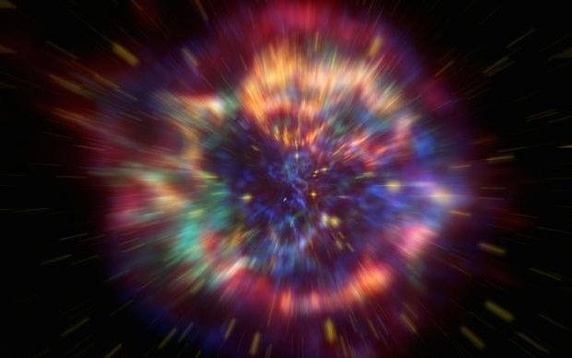



Comments